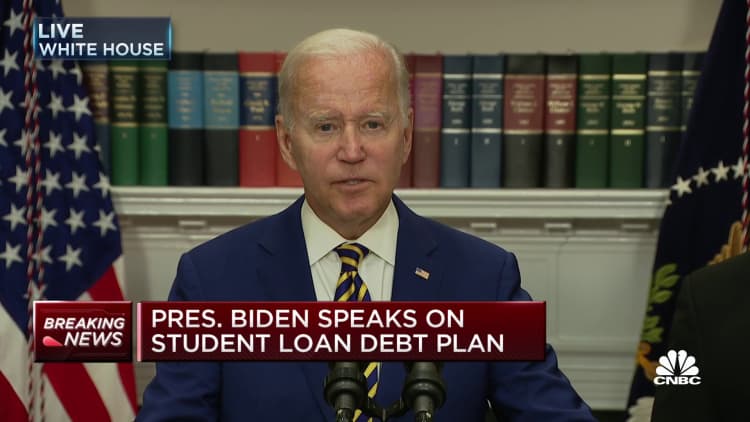Here's how up to $20,000 in student loan forgiveness could affect your credit score and ability to borrow
Here's what President Joe Biden's historic student loan forgiveness plan could mean for the credit reports of tens of millions of Americans.

Chaay_tee | Istock | Getty Images
Student debt can make it harder for people to start a business or purchase a home — and one reason for that is that lenders take into account your existing financial obligations.
Now that President Joe Biden has announced he plans to cancel up to $20,000 for millions of student loan borrowers, many people will find themselves with a more favorable balance sheet and possibly, a boosted credit score.
Biden said in late August that most federal student loan borrowers will be eligible for some forgiveness: up to $10,000 if they didn't receive a Pell Grant, which is a type of aid available to low-income undergraduate students, and up to $20,000 if they did. Meanwhile, other recent changes coming for student loan borrowers, including a second chance for those who had defaulted on their loans, may leave them in an even better financial situation.
More from Personal Finance:
What Biden's student loan forgiveness means for your taxes
Do you make too much for student loan forgiveness?
Student loan forgiveness applications could open within weeks
Here's what it all could mean for your credit.
Don't expect a 'huge' effect on your credit score
Student loan forgiveness will probably have a modest impact on your credit score, said Ted Rossman, a senior industry analyst at CreditCards.com.
"I don't think it will be huge," Rossman said.
That's because student loans are considered "installment loans," meaning a loan you repay over a set period of time with regularly scheduled payments. Those aren't weighted to heavily into your credit utilization rate, which is how much you're using of the credit available to you, he explained. Your utilization rate can account for up to 30% of your score.
Still, any score boost may help you get more favorable terms with other lenders.

Less debt may help you qualify to borrow more
Owing less on your student loans will improve your "debt-to-income ratio," which is the share of your monthly income used to pay your existing debts.
Lenders look at this ratio when deciding how much to let you borrow. Some use something called the 28/36 rule, which specifies that no more than 28% of your monthly gross income go toward housing costs, and no more than 36% go toward total debts. (A few mortgage lenders have even higher caps.)
Forgiveness that reduces or even eliminates your monthly student loan payments could lower that ratio, "potentially helping you qualify for a larger mortgage, car loan or credit card limit," Rossman said.
Credit report changes could take months after applying
Currently, the U.S. Department of Education is saying the application for loan cancellation will be available by early October, and that borrowers could see the relief within six weeks.
Borrowers can then expect to see their lowered or erased debt on their credit reports within roughly three months, Rossman said.
Owing less will help you make more headway with paying down credit card debt, boosting your savings and investments.
Ted Rossman
senior industry analyst at CreditCards.com
He recommends you check your report regularly for free at AnnualCreditReport.com to make sure all three credit rating companies — Experian, Equifax and TransUnion — are showing your correct balance. You can check your credit report weekly for free through the end of 2022.
Make sure you save a record of your reduced debt from your student loan servicer in case you need it as proof.
Borrowers in default have a chance to clear their record
The Education Department has also recently announced that it will be helping some 7 million student loan borrowers out of their defaulted status.
Once the so-called "Fresh Start" program launches, borrowers will start by choosing a repayment plan at MyEdDebt.Ed.Gov or by calling the Education Department's Default Resolution Group at 800-621-3115, said higher education expert Mark Kantrowitz.
Spxchrome | E+ | Getty Images
Your loans should then be transferred from the servicer that handles defaulted federal student loans, Maximus, to a new servicer. Once you have a new servicer and are enrolled in a payment plan, the default should be automatically cleared from your record, Kantrowitz said.
The opportunity is temporary. Borrowers will have a one-year window to switch into a new repayment plan, starting when the Covid-19 suspension of payments concludes. That's currently set to happen Dec. 31.
New payment plans could help borrowers' credit, too
Along with President Joe Biden's announcement last week on student loan forgiveness, he said the Education Department was moving to offer borrowers with undergraduate loans a new income-driven repayment plan that could slash their monthly bills in half. The plan could reduce the average annual student loan payment by more than $1,000, according to the White House.
Kantrowitz said this could have "a big impact on mortgage underwriting," since the other monthly financial obligations you have are a high consideration for lenders.
The plan isn't available to borrowers yet but they should keep checking for updates.
You can also take advantage of a lower or eliminated monthly student loan payment to advance on your other financial goals, Rossman said.
"Owing less will help you make more headway with paying down credit card debt, boosting your savings and investments," he said.

 Konoly
Konoly 

































